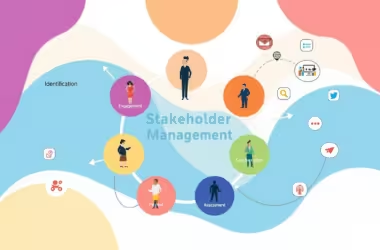What if your organization’s growth depends not on strategies, but on managing transitions well? Many companies look at change logistics. Yet, the truth is handling change effectively is key to smooth transitions. Organizations constantly encounter changes, from new strategies to tech upgrades. Each demands a careful approach for success.
In today’s fast-paced world, knowing how to manage change is vital. About 70% of change programs don’t achieve their goals. This often comes from resisting change or poor communication. This article digs into the crucial role of change management in organizational shifts. We’ll cover various transformation types, the role of change management software, and adaptation strategies.
Understanding Organizational Change
Organizational change is crucial in business, marking shifts that change a company. This talk will look at the organizational change definition. And show examples that make it clear how it works in real life.
Definition of Organizational Change
The organizational change definition includes big shifts in a business. These affect things like culture, tech, and how things are done. Factors leading to these changes may be new leaders, team changes, or new tech.
When a business changes, it might work more efficiently or change how it operates completely. Knowing about these changes helps businesses get ready and shows how they impact workers.
Examples of Organizational Change
There are many examples of organizational change out there. Here are some:
- Bringing in a new CEO who changes the company’s direction.
- Using new project management software instead of old ways of communicating.
- Changing team setups to work better together.
- Trying new business methods to keep up with the market.
These examples show why good change management is key. Such strategies help the new ideas work well, helping everyone in the company.
The Importance of Change Management
Change management is key in helping organizations navigate through changes. Recognizing its benefits transforms a company’s approach, ensuring easier shifts. Efficiently managing change brings many advantages, driving success.
Benefits of Effective Change Management
One of the main benefits is better employee involvement. If workers know what’s coming and understand it clearly, they’re likely to support the change.
The McKinsey study found projects with strong leadership are way more likely to succeed. Having a change advisory board with top leaders helps achieve goals.
- Increases Accountability: Clear roles boost ownership and performance.
- Promotes Continuous Improvement: Using feedback helps refine and enhance projects.
- Boosts Productivity: Good change management makes transitions easier, raising output.
Impact of Poor Change Management
On the other hand, bad change management has negative effects. A messy approach leads to confused and unhappy employees. This causes errors and decreases trust, lowering productivity and harming the culture.
- Increased Resistance: Without clear communication, people might resist new changes.
- High Turnover Rates: Feeling unsupported, some employees might choose to leave.
- Security Risks: Poor management increases the risk of security issues, affecting compliance.
Types of Organizational Change
It’s crucial for businesses to grasp the different types of organizational change. Each type stands out with its traits and impact. This shapes the way a company adapts and moves forward. Here, we explore the main kinds of change within organizations.
Strategic Changes
Strategic changes mean big shifts in a company’s aim or key goals. These might be sparked by new market needs or self-evaluation. For example, a business might focus more on improving what they already offer rather than creating new things. This affects the team’s objectives and what they prioritize. Such changes demand meticulous planning for successful implementation.
Process Changes
When we talk about process changes, it involves tweaks in how work gets done. This could be new ways of working, using tech differently, or changing how work is reviewed. Through adopting a new tool for better project management, everyone needs to adjust their work style. The goal here is to boost the organization’s efficiency and productivity in task completion.
Structural Changes
Structural changes mean altering the company’s setup, which can change jobs and what people are responsible for. It could mean the start of new groups, like an HR department, or the reshaping of current ones because of new chances or problems in the market. Keeping roles clear is key to prevent confusion and keep things running smoothly. Such changes really stand out when companies merge or are bought, as different organizational cultures need to merge.
The Change Spectrum
The change spectrum includes different types of changes that organizations meet. Knowing this spectrum helps find the right strategies for each situation. There are two main types: incremental change and transformational change.
Incremental Change
Incremental change means making small, step-by-step improvements. These can help organizations get better slowly. For example, they might start using new digital tools or tweak how things are done.
Even if these improvements don’t look big at first, they add up. Over time, they lead to big boosts in how well and efficiently an organization works.
Transformational Change
Transformational change, on the other hand, is about big shifts. It often means the organization must almost start over. A good example is when a business starts operating in other countries.
This kind of change requires many adjustments in how things are done, from operations to what resources are used. Transformational change changes the very essence of a business.
Change Management Software Development
Effective tools are key in the world of organizational change. Change management software is very important. It uses technology to help organizations manage changes well. This software helps teams plan, make, and keep track of changes. It makes sure changes go smoothly by improving communication and managing resources.
Overview of Change Management Software
These tools make managing change easier. They help organizations adapt to project changes, handle risks, and keep everyone informed. Change management software has features like automatic updates and real-time tracking. These help organizations adjust during times of change.
Choosing the Right Software for Your Needs
Choosing the right software takes thoughtful consideration. You need to think about what your organization needs and what you want to achieve. Here’s what to consider when selecting software:
- User-Friendliness: The software should be easy to use. This makes it easier for your team to learn how to use it.
- Integration Capabilities: It should work well with the systems and tools you already have.
- Customer Support: It’s important to have good technical support to solve problems fast.
- Scalability: The software should be able to grow with your organization and handle changes in project size.
- Features: Look for features that match your change management process. This includes tracking and reporting tools.
By thinking about these things, organizations can choose the best change management software. This supports their goals and makes handling changes more efficient.
Key Strategies for Successful Change Management
Implementing change management strategies is key for guiding an organization through transitions. By setting clear goals and including employees in this process, leaders can create a teamwork-driven environment. This fosters dedication among the workforce.
This discussion highlights two main elements vital for the success of any change efforts.
Clear Vision and Goals
A clear vision for the transition unites teams and directs efforts towards shared objectives. Explaining why the change is needed helps employees understand and accept it. Knowing the end goal and its reasons boosts their commitment.
A strong vision acts as a beacon during uncertain times in the process. It’s essential for keeping everyone moving forward together.
Involvement of Employees
Getting employees involved in change processes instills a sense of responsibility, increasing their dedication. This approach builds trust and teamwork, simplifying the implementation of change strategies. By seeking their input and ideas, organizations can tap into valuable insights.
Employee participation not only eases the transition but also sparks innovative solutions. It strengthens the organization on multiple levels.
The Role of Leadership in Change Management
Effective leadership is key in the success of change management. Leaders guide the change and build a supportive environment. They navigate transitions, impacting how change is adopted and applied organization-wide.
Communicating Change Effectively
Clear leadership is vital in change management. Leaders must communicate the why, how, and what of changes clearly. They use meetings, emails, and digital tools to keep everyone up to date. This builds trust and unity.
Research shows that understanding the benefits of changes makes employees more open to them. Good communication allows teams to quickly adjust to new customer and market needs.
Building Trust During Transitions
Trust is crucial for smooth change. Leaders earn trust by being open and addressing concerns quickly. This reduces uncertainty among team members.
Inviting employees into decision-making creates a sense of ownership. This commitment leads to a higher chance of change success. It shapes a supportive atmosphere necessary for managing change effectively.
Pitfalls to Avoid in Change Management
Making changes in an organization is tough. Knowing the common mistakes in change management can prevent bigger problems. Good strategies help improve morale and the culture of the company. They also tackle how employees react to changes.
Declining Morale and Company Culture
Changes in the organization can really impact how employees feel. If you don’t communicate changes well, employees can become unsure and disconnected. This confusion can lead to less motivation, hurting the culture more.
Putting effort into clear communication and regular updates is key. If companies ignore their culture during changes, they might see a big drop in how well the change efforts work.
Resistance to Change
It’s normal for people to resist changes, mostly because they are scared or unsure. This resistance can be obvious or hidden. It’s important to address these feelings early on.
Building an environment where change is seen as a chance to grow is helpful. This means having open talks and valuing everyone’s feedback. Since over 70% of employees resist changes when the communication is poor, it’s crucial for leaders to engage more.
Training and Support During Transitions
Training for organizational change is important. It helps employees feel ready and confident during shifts. Having enough resources makes adjusting easier and improves the transition.
Providing Adequate Resources
Right resources are key for successful change. They can include:
- Access to new tools and technologies
- Expert consultations for specialized guidance
- Updated workflow documentation that reflects new processes
These resources create a supportive environment, helping employees during transitions. It makes them feel empowered and informed. Strong leadership plays a big role too, promoting teamwork and openness.
Offering Ongoing Training Programs
Regular training programs help employees improve their skills for change. These programs can offer:
- Workshops focused on communication and emotional intelligence
- One-on-one coaching sessions for personalized support
- Internal support portals or forums for peer interaction
This approach eases transitions, bolstering the support system. Programs like Wharton Online’s Removing Barriers to Change highlight the value of readying leaders for tough times.
Monitoring Progress and Measuring Success
Monitoring change initiatives is key to measuring their success. Organizations can track progress and make smart decisions by setting clear metrics and regularly checking on them. This way, companies can tweak their strategies to better fit the changing environment.
Establishing Key Performance Indicators
Creating measurable metrics, known as Key Performance Indicators (KPIs), is crucial for evaluating change success. Important metrics to consider include:
- Speed of execution of change initiatives
- Adherence to established timelines
- Realized benefits and overall ROI
- Performance improvements in daily operations
- Project-specific KPIs
Tracking operational changes is more straightforward than broader organizational changes. Operational KPIs like user login numbers, transaction rates, and compliance results give valuable insights. Measuring success this way shows if employees are ready and on board, helping to reduce resistance.
Reviewing Outcomes and Adjusting Strategies
Reviewing outcomes regularly helps make needed strategy tweaks. This ensures organizations stay open to feedback. Things like employee satisfaction surveys and training participation show how well changes are accepted. High participation means a successful shift.
Taking employee feedback and timeline adherence into account improves change monitoring. Acknowledging the complexity of analyzing data during changes helps organizations refine their approach. This reduces risks linked to transitions.
Celebrating Success and Acknowledging Achievements
As organizations go through changes, it’s important to celebrate success in change management. This keeps momentum going and helps create a positive work atmosphere. Celebrating employee achievements boosts their morale. It also makes them more engaged, leading to better productivity and commitment.
Recognizing Employee Efforts
To build a culture of appreciation, effective recognition strategies are key. There are many ways to highlight achievements:
- Recognition events for individuals and teams help build teamwork. They make people feel their work is valued.
- Public shout-outs in social media or company newsletters are great for acknowledging hard work.
- Events after big changes boost engagement and motivation. They show continued support for the organization’s goals.
- A wall of fame for individual and team successes acts as a visual reminder of achievements, encouraging innovation.
Celebrating small wins during changes is also crucial. It keeps people motivated to strive for excellence and promotes positivity. Successes and lessons from change programs can be shared through emails, newsletters, and videos.
Gathering feedback on employee engagement offers insights into how well recognition efforts are working. Making sure everyone affected by the change feels included in celebrations is important. Regularly recognizing achievements highlights progress in change projects, opening doors for ongoing improvement.
Conclusion
Organizations are always changing, which makes managing these changes important. Good change management uses strong leadership and gets everyone involved. This way, companies can adjust easily without big problems. Change management lets businesses grow by accepting change.
Systematic checks on how changes affect things help everyone understand what’s going on. Change advisory boards (CAB) keep all people updated and involved. This stops problems from getting worse. Using good change management practices reduces risks. It also makes customers happier because updates meet their needs better.
Organizations that focus on managing changes well do better overall. They become more efficient and face fewer risks. By making change a key part of how they work, businesses can deal with future challenges and grab new opportunities.






